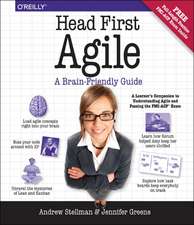Specifying Software: A Hands-On Introduction
Autor R. D. Tennenten Limba Engleză Paperback – 24 feb 2002
| Toate formatele și edițiile | Preț | Express |
|---|---|---|
| Paperback (1) | 336.65 lei 6-8 săpt. | |
| Cambridge University Press – 24 feb 2002 | 336.65 lei 6-8 săpt. | |
| Hardback (1) | 612.70 lei 6-8 săpt. | |
| Cambridge University Press – 24 feb 2002 | 612.70 lei 6-8 săpt. |
Preț: 336.65 lei
Preț vechi: 420.81 lei
-20% Nou
Puncte Express: 505
Preț estimativ în valută:
64.45€ • 66.28$ • 53.47£
64.45€ • 66.28$ • 53.47£
Carte tipărită la comandă
Livrare economică 19 februarie-05 martie
Preluare comenzi: 021 569.72.76
Specificații
ISBN-13: 9780521004015
ISBN-10: 0521004012
Pagini: 302
Ilustrații: 29 b/w illus. 1 table 215 exercises
Dimensiuni: 156 x 235 x 23 mm
Greutate: 0.43 kg
Editura: Cambridge University Press
Colecția Cambridge University Press
Locul publicării:New York, United States
ISBN-10: 0521004012
Pagini: 302
Ilustrații: 29 b/w illus. 1 table 215 exercises
Dimensiuni: 156 x 235 x 23 mm
Greutate: 0.43 kg
Editura: Cambridge University Press
Colecția Cambridge University Press
Locul publicării:New York, United States
Cuprins
Introduction; Part I. Algorithms: 1. Specifying algorithms; 2. Verifying algorithms: basic techniques; 3. Verifying algorithms: some examples; 4. Additional verification techniques; Part II. Data Representations: 5. Data representation: a case study; 6. Data representation: additional examples; Part III. Language Recognizers: 7. Basic concepts; 8. State-transition diagrams; 9. Regular languages; 10. Context-free languages; 11. Parsing; 12. A taste of computability theory; Appendix A: programming language reference; Appendix B: hints for selected exercises; Index.
Recenzii
'The treatment of state diagrams or grammars as specialized specification languages and embedding them into a more general context of specifying algorithms and data representations is an interesting approach that is quite novel … I would like to single out both the author's approach and his style of presentation as very positive features of the book. Reading this book is definitely inspiring, and not just for a student.' Computing Reviews
'This book was written to support a short course in the second or third year of an undergraduate computer science, software engineering, or software design program. The prerequisites are fairly modest: some programming experience and some exposure to the most basic concepts of discrete mathematics and to the language of elementary logic. Using this book will help readers improve their programming skills and develop a solid foundation for subsequent courses in advanced algorithms and data structures, software design, formal methods, and compilers.' Zentralblatt für Mathematik
'This book was written to support a short course in the second or third year of an undergraduate computer science, software engineering, or software design program. The prerequisites are fairly modest: some programming experience and some exposure to the most basic concepts of discrete mathematics and to the language of elementary logic. Using this book will help readers improve their programming skills and develop a solid foundation for subsequent courses in advanced algorithms and data structures, software design, formal methods, and compilers.' Zentralblatt für Mathematik
Descriere
An innovative hands-on introduction to techniques for specifying the behaviour of software components.















